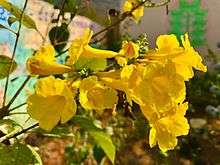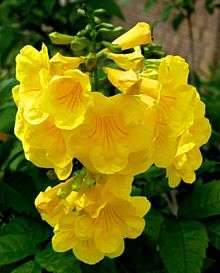| Tecoma stans |
 |
|
Scientific classification  |
| Kingdom: | Plantae |
| Clade: | Angiosperms |
| Clade: | Eudicots |
| Clade: | Asterids |
| Order: | Lamiales |
| Family: | Bignoniaceae |
| Genus: | Tecoma |
| Species: |
T. stans |
| Binomial name |
Tecoma stans
|
|
| Synonyms[1] |
- Bignonia frutescens Mill. Synonym
- Bignonia incisa DC. [Invalid] Synonym
- Bignonia sorbifolia Salisb. Synonym
- Bignonia stans L. Synonym
- Bignonia tecoma Wehmer Synonym
- Bignonia tecomoides DC. Synonym
- Gelseminum stans (L.) Kuntze Synonym
- Stenolobium incisum Rose & Standl. Synonym
- Stenolobium quinquejugum Loes. Synonym
- Stenolobium stans (L.) Seem. Synonym
- Stenolobium stans var. apiifolium (DC.) Seem. Synonym
- Stenolobium stans var. multijugum R.E.Fr. Synonym
- Stenolobium stans var. pinnatum Seem. Synonym
- Stenolobium tronadora Loes. Synonym
- Tecoma incisa (Rose & Standl.) I.M.Johnst. Synonym
- Tecoma molle Kunth Synonym
- Tecoma stans var. angustatum Rehder Synonym
- Tecoma stans var. apiifolia DC. Synonym
- Tecoma stans var. stans Synonym
- Tecoma tronadora (Loes.) I.M.Johnst. Synonym
- Tecoma velutina Lindl. Synonym
|
Tecoma stans is a species of flowering perennial shrub in the trumpet vine family, Bignoniaceae, that is native to the Americas. Common names include yellow trumpetbush,[2] yellow bells,[2] yellow elder,[2] ginger-thomas. Tecoma stans is the official flower of the United States Virgin Islands and the floral emblem of The Bahamas.
Description

Yellow trumpetbush -- Tecoma stans
Yellow trumpetbush is an attractive plant that is cultivated as an ornamental. It has sharply toothed, lance-shaped green leaves and bears large, showy, bright golden yellow trumpet-shaped flowers. It is drought-tolerant and grows well in warm climates. The flowers attract bees, butterflies, and hummingbirds.[3] The plant produces pods containing yellow seeds with papery wings. The plant is desirable fodder when it grows in fields grazed by livestock. Yellow trumpetbush is a ruderal species, readily colonizing disturbed, rocky, sandy, and cleared land and occasionally becoming an invasive weed.
External links
Taxon identifiers |
|---|
| Tecoma stans | |
|---|
| Bignonia stans | |
|---|

